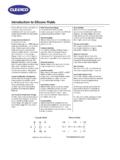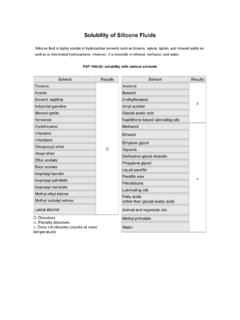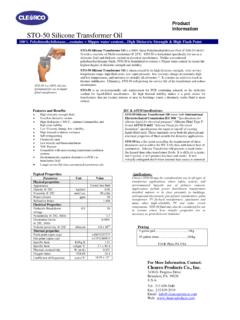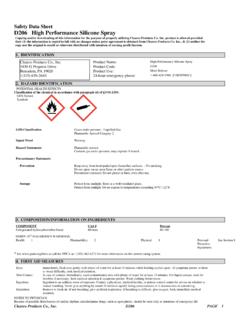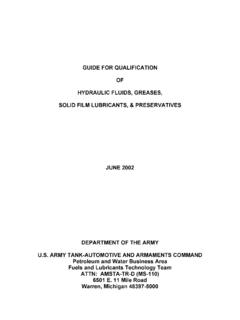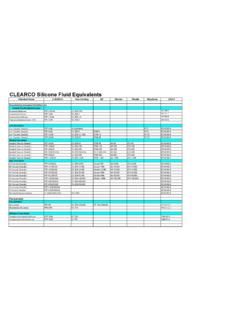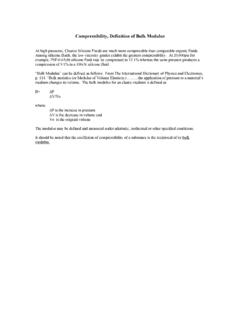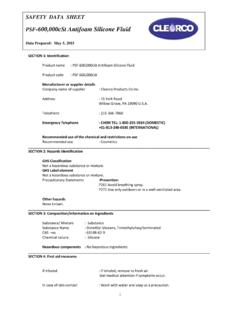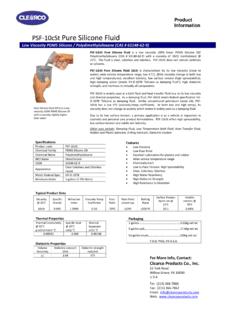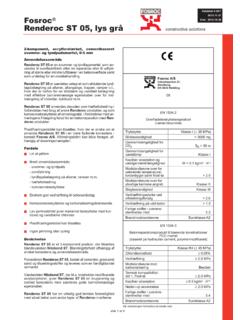Transcription of MSDS-High Performance Silicone Mold Release
1 msds HP Silicone 1 SECTION 1 CHEMICAL PRODUCT AND COMPANY IDENTIFICATION Product Name: high Performance Silicone mold Release Provided by: CLEARCO PRODUCTS CO. INC., 15 York Rd. Willow Grove, PA 19090 Telephone No: 001 215 366-7860 Fax No: 001 215 366-7862 E-mail: Website: Emergency Telephone: CHEM TEL.
2 1-800-255-3924 (DOMESTIC) +01-813-248-0585 (INTERNATIONAL) SECTION 2 COMNPOSITION / INFORMATION ON INGREDIENTS INGREDIENTS / COMPONENTS CAS Number ACGIH TLV Exposure Limited OSHA PEL Other Halogenated Hydrocarbon/ Ether Blend MIXTURE None Established None Established Not Established NJ Trade Secret Registry #80100382-5037P None Established None Established Not Established SECTION 3 HAZARDS IDENTIFICATION HMIS Health: 1 Flammability: 2 Reactivity: 1 Personal Protective Equipment: See Section 8 * See or call the NPCA at 1 (202) 462-6272 for more information on this current rating system.
3 POTENTIAL ACUTE (single or short term) HEALTH EFFECTS OF OVEREXPOSURE Eye: May cause eye irritation. Symptoms may include stinging, tearing and redness. Skin: Liquid may cause frostbite. Ingestion: Ingestion is not considered a potential route of exposure. No evidence of harmful effects from available information. Inhalation: Breathing small amounts during handling is not likely to cause harmful effects from available information. Inhalation of concentrations above the recommended limits may cause temporary central nervous system depression with anesthetic effects such as dizziness, headache, incoordination, and loss of consciousness.
4 Exposure to high concentrations can cause irregular heartbeat, cardiac arrest and death. POTENTIAL CHRONIC (repeated or long term) HEALTH EFFECTS OF OVEREXPOSURE General Effects: Overexposure to vapor, dust or mist may aggravate existing respiratory conditions, such as asthma, bronchitis, and inflammatory or fibrotic respiratory disease. Cancer Information: THIS PRODUCT CONTAINS NO COMPONENTS LISTED AS CARCINOGENIC BY IARC, NTP, OR OSHA (1910(Z) Mutagenicity: No data available to indicate product or any components present at greater than is mutagenic or genotoxic.)
5 MEDICAL CONDITIONS AGGRAVATED BY OVEREXPOSURE: Individuals with preexisting diseases of the central nervous or cardiovascular system may have increased susceptibility to the toxicity of excessive exposures. SECTION 4 FIRST AID MEASURES Eye: Immediately flush eyes gently with plenty of water for at least 15 minutes while holding eyelids apart. If symptoms persist or there is visual difficulty, seek medical attention. Skin Contact: In case of contact, immediately wash contaminated area with plenty of water for at least 15 minutes.
6 Seek medical attention if symptoms persist. Wash clothing before reuse. For liquid contact, treat for frostbite if necessary. Ingestion: Ingestion is an unlikely route of exposure. Contact a physician, medical facility, or poison control center for advice on whether to induce vomiting. Never give anything by mouth if victim is rapidly losing consciousness or is unconscious or convulsing. Material Safety Data Sheet high Performance Silicone mold Release Data Prepared: October 15th, 2014 msds HP Silicone 2 Inhalation: Remove to fresh air.
7 If not breathing, give artificial respiration. If breathing is difficult, give oxygen. Seek immediate medical attention. NOTES TO PHYSICIAN: Because of possible disturbances of cardiac rhythm, catecholamine drugs, such as epinephrine, should be used only in situations of emergency life support. SECTION 5 FIRE FIGHTING MEASURES Fire and Explosion Hazards: This product contains a component (s) that is considered extremely flammable gas(es), which has vapors that are heavier than air and may travel along the ground or be moved by ventilation and ignited by head, pilot lights, or other flames and ignition sources at locations distant from the material s handling point.
8 Containers may rupture or explode under fire conditions. Hazardous decomposition products may be formed (see Sec,10). Fire Fighting Instructions: Use CO2, foam or dry chemical. Water is generally not effective and may spread fire; however, water spray may be used from a safe distance to cool closed containers and protect surrounding area. Aerosol Flame Projection Test: Non-flammable aerosol, as determined by ASTM D3065-94. However, this product contains components which may be ignited under certain circumstances.
9 Do not use near ignition sources such as sparks or open flames. SECTION 6 ACCIDENTAL Release MEASURES STEPS TO BE TAKEN IF MATERIAL IS RELEASED OR SPILLED: Ventilate contaminated area. Remove all sources of ignition. Wear appropriate personal protective equipment (PPE). Stop or reduce discharge if it can be done safely. Avoid run-off into storm sewers and ditches which may lead to natural waterways. Clean up with absorbent material. Place absorbent materials into container and close tightly. Dispose of container properly.
10 If runoff occurs, notify authorities as required. SECTION 7 HANDLING, STORAGE AND DISOSAL Handling: Use with adequate ventilation. Do not use near ignition sources. Avoid prolonged or repeated contact with skin. Avoid prolonged or repeated breathing of vapor. Normal precautions common to safe manufacturing practice should be following in handling and storage. Storage: Store in a cool, dry, well ventilated area away from all sources of ignition. Do not store at temperatures above 120 degrees F. Empty container may contain residues which are hazardous.
